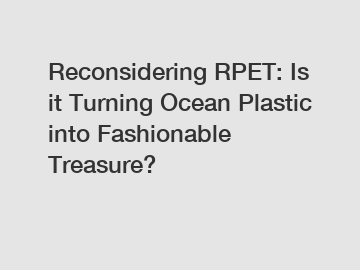Feb. 05, 2024
Environment
Reconsidering RPET: Is it Turning Ocean Plastic into Fashionable Treasure?
Plastic pollution has become an escalating concern for our planet, with millions of tons of plastic waste ending up in our oceans each year. In recent years, there has been a growing interest in exploring sustainable solutions to tackle this problem. One such innovation is the use of Recycled Polyethylene Terephthalate, or RPET, as a material for fashion products. But is RPET truly turning ocean plastic into fashionable treasure? Let's delve deeper into this topic to understand its implications.
1. Understanding RPET:

RPET is a form of recycled plastic made from Polyethylene Terephthalate, commonly found in single-use plastic bottles. This recycled material is transformed into fibers, fabrics, and yarns, which serve as alternatives to traditional polyester. By utilizing RPET, the fashion industry aims to reduce its reliance on virgin resources and decrease the amount of plastic waste that ends up in landfills and oceans.
2. The Fashion Industry's Efforts:
Fashion brands and designers have been increasingly incorporating RPET into their collections as part of their sustainability initiatives. By doing so, they hope to raise awareness about plastic pollution while providing consumers with eco-friendly choices. The use of RPET also aligns with the growing demand for sustainable fashion, which encourages consumers to make more responsible purchasing decisions.
3. Environmental Impact:
The primary advantage of using RPET is its positive environmental impact. By upcycling discarded plastic bottles, RPET helps contribute to the reduction of ocean plastic pollution. It also reduces energy consumption and greenhouse gas emissions associated with the production of virgin polyester. Additionally, RPET can be further recycled, extending its lifespan and reducing the overall burden on the environment.
4. Challenges and Limitations:
While RPET offers several benefits, it is essential to acknowledge some of the challenges and limitations associated with its use. Firstly, the process of converting plastic bottles into RPET fibers requires specialized recycling infrastructure, which may not be available in all regions. Secondly, the quality and durability of RPET products can vary, leading to concerns about their longevity and performance compared to traditional polyester. Lastly, there is a potential risk of microplastic shedding from RPET fabrics, which can have adverse effects on marine life and ecosystems.
5. Misleading Marketing Claims:
As the demand for sustainable fashion rises, some brands may make misleading claims about their products' eco-friendliness. This greenwashing can mislead consumers into believing they are supporting a greener alternative when, in reality, the product may not be as environmentally friendly as it seems. It is crucial for consumers to stay informed and look for certifications or transparency from brands to ensure the authenticity of their sustainability claims.
6. The Path Forward:
While RPET offers a viable solution for reducing plastic waste, it is not the ultimate answer to the plastic pollution crisis. It is essential to focus on implementing a circular economy approach, whereby plastic waste is effectively managed and recycled. This includes improving recycling infrastructure, promoting consumer education, and encouraging brands to take responsibility for the entire life cycle of their products. In conjunction with RPET, exploring other sustainable and biodegradable alternatives can help create a more comprehensive solution.
In conclusion, RPET has the potential to turn ocean plastic into fashionable treasure by diverting plastic waste from our oceans and landfills. The fashion industry's adoption of RPET showcases a growing commitment to sustainability. However, it is crucial to address the challenges associated with its use, such as specialized recycling infrastructure and potential environmental impacts. The success of RPET lies in creating a holistic approach that combines responsible recycling practices, transparent marketing, and continuous innovation towards a more sustainable fashion industry. By reconsidering RPET and its role in the larger context of plastic pollution, we can move closer to a world where fashion can truly be synonymous with environmental responsibility.
Want more information on rPET pellets, rPET pellets, rPET pellets? Feel free to contact us.
Previous: Where can I order the top-rated oil activated carbon filter element in Denmark?
Next: What are the two most popular types of anti-static bags?
If you are interested in sending in a Guest Blogger Submission,welcome to write for us!
All Comments ( 0 )